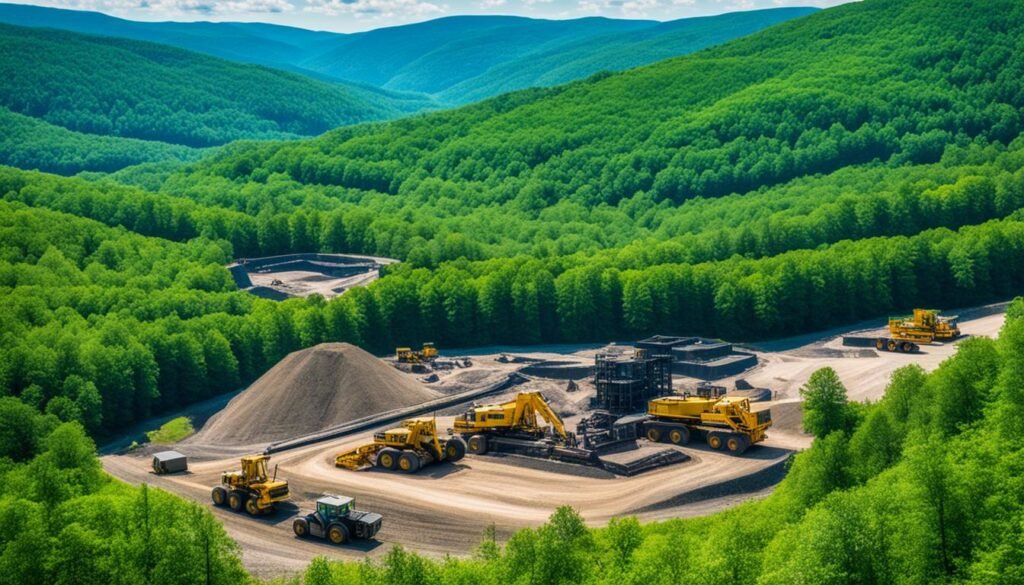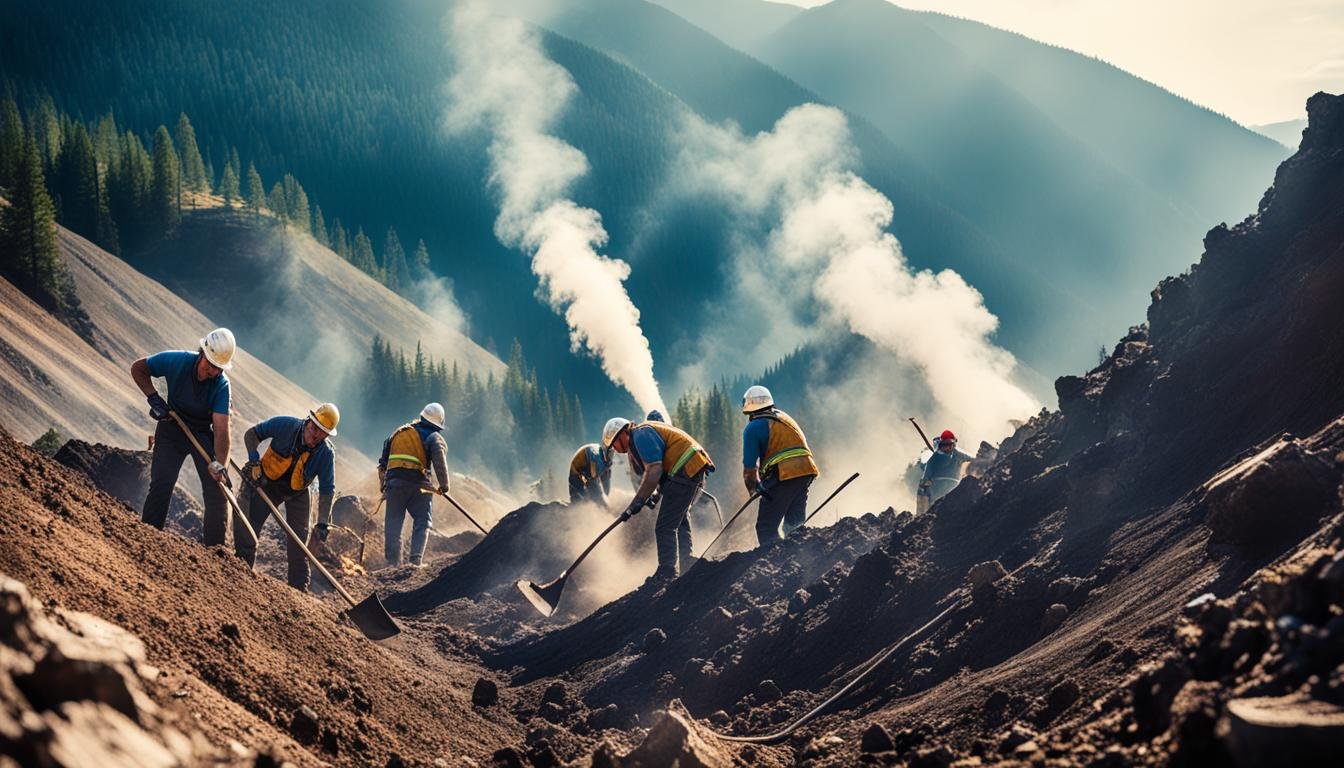Did you know that Pennsylvania has a rich history of gold mining?
While it may not be as well-known as California’s gold rush, gold mining in Pennsylvania has played a significant role in shaping the state’s economy and labor market. But what are the insights and facts behind this fascinating industry?
Key Takeaways about Gold Mining in Pennsylvania
- Pennsylvania has a rich history of gold mining
- Gold mining companies contribute significantly to the state’s economy
- The industry has implemented innovative environmental strategies and technologies
- Gold mining creates job opportunities in Pennsylvania
- Sustainability is a key focus in the gold mining sector
We will delve into the history of gold mining in Pennsylvania, explore the current landscape of gold mining companies, uncover the environmental strategies and technologies used in the industry, and examine the economic impact and potential.
Get ready to discover the hidden stories and important facts surrounding gold mining in Pennsylvania.
The Alluring History of Gold Mining in Pennsylvania
The history of gold mining in Pennsylvania is filled with intriguing stories and legends. One of the most famous tales is the legend of the Lost Union Gold, which is believed to have disappeared during its transportation to the U.S. Mint in Philadelphia. The Dents Run Enigma refers to a court-ordered release of government documents related to the FBI’s search for the lost gold and the ongoing debate around a possible cover-up.
The Legend of Lost Union Gold: The Dents Run Enigma
The legend of the Lost Union Gold has captivated the imaginations of treasure hunters and history enthusiasts for years. It is said that in 1863, during the Civil War, a Union Army payroll train carrying millions of dollars worth of gold left Wheeling, West Virginia, destined for the U.S. Mint in Philadelphia. However, the gold never reached its intended destination. The prevailing belief is that the gold was intercepted and hidden in the remote and rugged Dents Run area of Pennsylvania.
The mystery surrounding the Lost Union Gold has been further fueled by the Dents Run Enigma. In 2018, after years of legal battles, a judge ordered the release of classified government documents related to the FBI’s search for the lost gold. These documents have sparked widespread speculation and debate about the existence and whereabouts of the gold. Some believe that the government covered up the truth about the lost treasure, while others remain skeptical.
Mining Laws Since the 1800s and Historical Mine Maps
Since the early days of gold mining in Pennsylvania, various mining laws and regulations have shaped the industry. The first comprehensive mining law in the state was enacted in 1873, providing guidelines for prospecting, digging, and operating mines. Over the years, these laws have been revised and updated to ensure the safety of miners and protect the environment.
Historical mine maps have played a crucial role in documenting the mining activities and locations in Pennsylvania. These maps provide valuable insights into the state’s gold mining history, highlighting the areas where mining operations were most prominent. They also serve as a valuable resource for researchers, historians, and geologists studying the industry’s impact on the landscape.
The Infamous Quecreek Mine Incident and Mapping Implications
The Quecreek Mine incident, which occurred in 2002, significantly impacted Pennsylvania’s gold mining industry and emphasized the importance of accurate mapping. During this incident, nine miners were trapped underground for 77 hours after breaching into a neighboring, water-filled mine. The incident resulted in a massive rescue effort and highlighted the need for comprehensive mapping and monitoring of mining operations to prevent such accidents.
Following the Quecreek Mine incident, mapping technologies and practices have been improved to enhance safety and prevent similar occurrences. Modern mapping techniques, such as georeferencing and vectorizing, have been implemented to create detailed and precise mine maps. These maps help to identify potential risks, locate underground resources, and ensure the safety of miners.
Famous Legends and Incidents in Pennsylvania Gold Mining History
| Legend/Incident | Description |
| The Lost Union Gold | A legend surrounding a missing Union Army payroll train carrying millions of dollars worth of gold during the Civil War. Believed to have been hidden in the Dents Run area of Pennsylvania. |
| Dents Run Enigma | The ongoing debate and speculation surrounding the court-ordered release of government documents related to the FBI’s search for the Lost Union Gold. |
| Quecreek Mine Incident | The incident in 2002 where nine miners were trapped underground for 77 hours after breaching into a neighboring, water-filled mine. Highlighted the importance of accurate mapping and monitoring in mining operations. |
Current Landscape of Gold Mining Companies in Pennsylvania
Pennsylvania boasts a thriving gold mining industry, supported by a wide range of renowned companies. These companies are involved in every stage of the gold mining process, from exploration and prospecting to extraction and production. Their collective efforts contribute significantly to the state’s economy and labor market, providing job opportunities and driving the overall growth of the industry.
Some of the notable gold mining companies in Pennsylvania include:
- Company A: With decades of experience in the industry, Company A specializes in advanced exploration techniques and state-of-the-art extraction methods. They have a proven track record of successful gold mining operations across the state.
- Company B: Known for their commitment to ecological sustainability, Company B implements innovative mining practices to minimize the environmental impact. They prioritize responsible extraction methods and employ advanced technologies for efficient and responsible gold production.
- Company C: Focused on community engagement and social responsibility, Company C actively collaborates with local stakeholders to ensure mutually beneficial outcomes. They prioritize the well-being of their employees and strive to create a positive impact on the communities where they operate.
These companies, along with many others, contribute to the development of Pennsylvania’s gold mining industry, ensuring a sustainable and prosperous future for the sector.

Gold Mining in Pennsylvania: Environmental Strategies and Technologies
As gold mining continues in Pennsylvania, the industry has implemented various environmental strategies and technologies to minimize its impact on the environment. These initiatives focus on sustainable practices and innovative solutions to ensure responsible mining operations.
Pioneering Reclamation: The EcoIslands Approach
One notable environmental strategy is the pioneering reclamation method known as the EcoIslands approach. This approach aims to create low-maintenance, efficient systems for water remediation in mining areas. By utilizing natural systems and engineered solutions, the EcoIslands approach promotes the restoration of ecosystems and the preservation of water quality.

Digitalizing History: PA Department of Environmental Protection’s Initiative
The Pennsylvania Department of Environmental Protection (PA DEP) has taken a proactive step towards environmental preservation by initiating a digitalization project. This project involves converting historical mine maps into digital format, making them more accessible and easier to analyze. By digitizing these maps, the PA DEP aims to improve decision-making processes and enhance environmental monitoring efforts.
Georeferencing and Vectorizing: Modern Mapping for Mining Safety
To ensure mining safety and optimize operations, modern mapping techniques have become essential in the gold mining industry. Georeferencing and vectorizing historical mine maps enable accurate spatial analysis and visualization of mining activities. This technological advancement aids in identifying potential risks, optimizing resource allocation, and implementing effective safety measures.
| Environmental Strategies and Technologies | Benefits |
|---|---|
| EcoIslands Approach | Promotes water remediation Restores ecosystems |
| PA DEP’s Digitalization Project | Enhances environmental monitoring Improves decision-making |
| Georeferencing and Vectorizing | Ensures mining safety Optimizes resource allocation |
By embracing environmental strategies such as the EcoIslands approach, digitalization initiatives, and modern mapping technologies, the gold mining industry in Pennsylvania demonstrates its commitment to responsible practices and sustainable development. These advancements not only minimize the environmental impact but also contribute to the long-term viability of gold mining operations.
Unearthing Profitability: The Economic Impact and Potential
The economic impact of gold mining in Pennsylvania is significant, contributing to job creation and bolstering the local and state economies. The value chain of gold mining, from extraction to distribution, plays a crucial role in driving economic growth and sustainability in the industry.
From Extraction to Distribution: The Value Chain
The process of gold mining encompasses various interconnected stages that form the value chain. It starts with exploration, where geologists survey potential mining sites and assess the viability of gold deposits. Once a suitable site is identified, extraction methods such as open-pit or underground mining are employed to extract the valuable ore.
After extraction, the ore goes through a series of processes, including crushing, grinding, and chemical treatments, to extract the gold from the surrounding rock and minerals. The extracted gold is then refined to achieve a high level of purity and prepared for distribution and sale in both domestic and international markets.
The value chain in gold mining involves multiple stakeholders, including miners, equipment manufacturers, transportation companies, refineries, and gold traders. Each stage in the value chain creates opportunities for job creation and economic growth, making gold mining a vital sector in Pennsylvania.
Job Creation and Market Trends in the Gold Industry
Gold mining in Pennsylvania serves as a significant source of employment, offering job opportunities across various sectors. The industry provides employment not only for miners but also for professionals in areas such as geology, engineering, environmental sciences, and logistics. Additionally, the mining industry indirectly supports other related industries, such as manufacturing and transportation, further contributing to job creation.
Market trends play a crucial role in the economic potential of gold mining. The value of gold is influenced by factors such as global demand, economic conditions, and geopolitical events. Understanding market trends and adapting to changes in demand and pricing helps mining companies navigate fluctuations and maintain profitability. Market analysis and forecasting are essential tools for gold mining companies to make informed decisions and ensure long-term sustainability in the industry.
Pursuing Sustainability in the Gold Mining Sector
As the gold mining industry continues to grow, the pursuit of sustainability becomes paramount. Mining companies are increasingly adopting environmentally friendly practices to minimize the ecological impact of their operations. This includes implementing responsible mining techniques, reclaiming disturbed lands, and reducing air and water pollution through innovative technologies.
Sustainability in gold mining also involves considering the social and economic aspects of the industry. Mining companies strive to engage with local communities, ensure fair labor practices, and contribute to the overall well-being of the regions in which they operate. By prioritizing sustainability, the gold mining sector aims to create a positive and lasting impact on both the environment and society.

Conclusion
In conclusion, gold mining in Pennsylvania has a rich history and continues to be an important industry in the state. From the captivating tales of the Lost Union Gold and the Dents Run Enigma to the implementation of innovative environmental strategies and technologies, the industry has evolved and adapted over the years.
Gold mining in Pennsylvania plays a crucial role in the state’s economy, contributing to job creation and economic growth. The value chain, from extraction to distribution, generates opportunities for employment and supports local businesses. The industry’s commitment to sustainability ensures that future generations can benefit from its resources without compromising the environment.
As the gold mining industry in Pennsylvania moves forward, sustainability will be at the forefront of its development. Companies will continue to adopt responsible practices and technologies, prioritizing safety and ecological responsibility. By doing so, gold mining in Pennsylvania can continue to thrive and contribute to both the state’s economy and the well-being of its communities.
FAQ about Gold Mining in Pennsylvania
What is the history of gold mining in Pennsylvania?
The history of gold mining in Pennsylvania is filled with intriguing stories and legends. One famous tale is the legend of the Lost Union Gold, believed to have disappeared during transportation to the U.S. Mint in Philadelphia. Another notable event is the Dents Run Enigma, which refers to a court-ordered release of government documents related to the FBI’s search for the lost gold and the ongoing debate around a possible cover-up.
What gold mining companies operate in Pennsylvania?
Pennsylvania is home to a wide range of gold mining companies, each offering unique services and products. These companies are involved in various stages of the gold mining process, from exploration to extraction and production. Some notable gold mining companies in Pennsylvania include [insert company names] and they contribute to the state’s economy and labor market by providing job opportunities and contributing to the overall growth of the industry.
What environmental strategies and technologies are used in gold mining in Pennsylvania?
As gold mining continues in Pennsylvania, the industry has implemented environmental strategies and technologies to minimize its impact on the environment. One such approach is the pioneering reclamation method known as the EcoIslands approach. The Pennsylvania Department of Environmental Protection has also initiated a digitalization project to convert historical mine maps into a digital format, making them more accessible and easier to analyze. Georeferencing and vectorizing these maps have also become essential for modern mapping techniques to ensure mining safety.
What is the economic impact of gold mining in Pennsylvania?
Gold mining in Pennsylvania has a significant economic impact, creating jobs and contributing to the local and state economies. The industry’s value chain, from extraction to distribution, provides job creation potential. This section will explore the value chain of gold mining and discuss market trends in the gold industry. Additionally, pursuing sustainability in gold mining practices is vital for the industry’s future economic potential.








